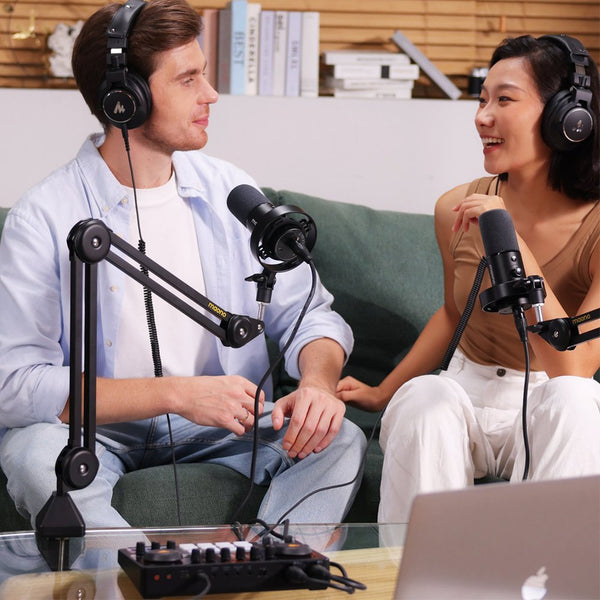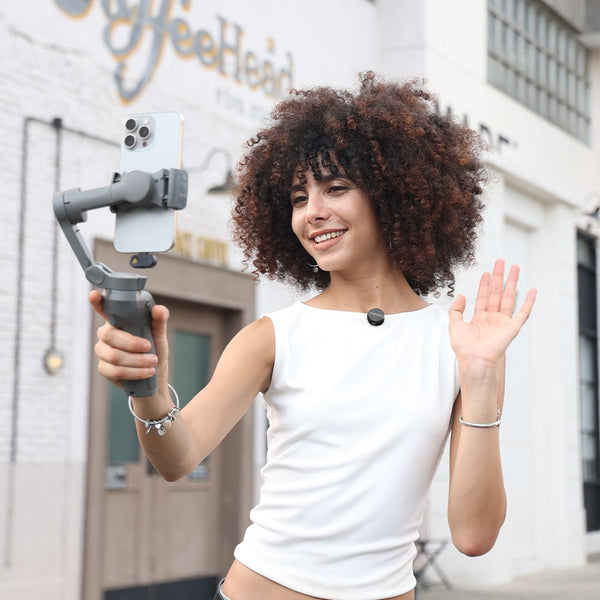Microphone technology has rapidly evolved in recent years, driven largely by the increasing demand for clearer audio in streaming, podcasting, and content creation. Whether you're a beginner or a seasoned pro, finding the best USB microphone has become essential for achieving professional sound without complicated setups. One of the standout features in modern microphones is DSP noise reduction. But what exactly does that mean, and why is it such a game-changer for creators?
What Is Built-in DSP Noise Reduction in Microphones and How Does It Work?
DSP stands for Digital Signal Processing—a technology that uses algorithms to manipulate audio signals in real-time. In microphones, built-in DSP noise reduction refers to a digital chip integrated into the mic’s circuitry that processes sound input to eliminate unwanted background noise while preserving vocal clarity.
This feature enables the mic to distinguish between the voice (the desired signal) and noise (unwanted sounds like fans, traffic, or room echo), then reduce or completely filter out the latter before it even reaches your recording software or livestream audience.
This kind of processing has become a defining feature in many of the best USB microphones available today, ensuring that your recordings sound professional—even if your environment is less than ideal.
What Does DSP Stand For in Microphone Technology?
DSP stands for Digital Signal Processing. It’s a method of analyzing, modifying, and optimizing signals—like sound—after converting them from analog to digital. In microphones, DSP is used for a variety of tasks: from equalization and compression to echo suppression and, notably, noise reduction.
How Does DSP Noise Reduction Actually Remove Background Sounds?
DSP noise reduction algorithms rely on pattern recognition and frequency analysis. They "learn" the characteristics of background noise—typically steady or repetitive signals—and subtract them from the overall audio input. This is done in real-time, with minimal delay, allowing for clean vocals that are ready for livestreams, podcasts, or recording sessions. Many of the best USB microphones for vocals rely on this feature to deliver studio-like clarity even in makeshift home recording setups.
Advantages of DSP Noise Reduction for Streaming, Singing, and Podcasting
For streamers, singers, and podcasters alike, clean audio is not a luxury—it’s a necessity. DSP noise reduction offers several benefits:
-
Professional Sound Quality
Reduces ambient noise for a more polished final product.
-
Less Post-Editing
With clean input audio, there's less need for post-production filtering.
-
Greater Flexibility
Record from less-than-ideal environments without compromising clarity.
-
Real-Time Monitoring
Hear your voice clearly in your headphones without interference from background distractions.
-
Fatigue-Free Listening
For podcast listeners or video audiences, cleaner audio is easier on the ears.
Whether you're belting out a vocal track, recording a sermon, or live-streaming gameplay, a microphone with DSP noise reduction lets you focus on your performance—not your environment. These benefits are why DSP is commonly found in a high-quality USB studio microphone.
How DSP Noise Reduction Compares to Traditional Noise Filters
Traditional noise reduction techniques—such as foam windscreens, analog filters, or noise gates—can help mitigate background noise, but they often require manual setup and can cut off soft vocal parts or allow some noise to slip through.
Here’s how DSP compares:
|
Feature |
Traditional Filters |
DSP Noise Reduction |
|
Effectiveness |
Moderate |
High |
|
Real-time Processing |
Limited |
Yes |
|
Customization |
Manual |
Automated/Adaptive |
|
Hardware Dependency |
External accessories |
Built-in |
|
Audio Quality Preservation |
Variable |
High |
In essence, DSP noise reduction is smarter, faster, and more efficient. It adapts dynamically to the sound environment, ensuring your vocals remain front and center while everything else fades into the background. If you're looking for the best budget USB microphone with this capability, several models under $150 now offer built-in DSP.
Using DSP Noise Reduction Mics in Noisy Environments: Home, Office, Outdoors
One of the most appealing features of DSP-enabled microphones is their versatility in various environments:
-
Home Studios: Cancel out appliance hums, computer fans, or distant conversations.
-
Offices: Great for virtual meetings and content creation in shared or open spaces.
-
Outdoor Locations: Helps reduce wind noise, traffic sounds, or nature sounds like rustling leaves and chirping birds.
While it's still ideal to record in a quiet space, DSP makes it possible to produce quality audio even when conditions aren’t perfect. That’s why many creators turn to a USB vocal microphone with DSP when working outside the studio.
How to Tell If Your Microphone Has DSP Noise Reduction (And How to Use It)
If you're shopping for a microphone or unsure whether your current mic has DSP capabilities, look for the following indicators:
-
Product Specs: Check the manufacturer's site or packaging for mentions of “DSP,” “built-in noise reduction,” or “digital signal processor.”
-
Toggle or Indicator: Some mics have a button or software setting to activate DSP features.
-
Reviews or Demonstrations: Product reviews or YouTube demonstrations often highlight DSP performance.
To use it:
-
Ensure DSP is enabled (either automatically or via settings/software).
-
Speak normally into the mic and monitor your input.
-
Adjust gain levels, but don’t overcompensate—DSP does the heavy lifting.
A great example of an affordable mic with excellent DSP noise reduction is the Maono PM450, a USB studio microphone designed for budget-conscious creators.
FAQ Section
Does DSP Work Well for Outdoor Recordings or Live Music Events?
Yes, but with limitations. While DSP effectively reduces wind and background chatter, it can struggle with highly dynamic noise like live instruments or shouting crowds. For outdoor vocals, however, it does a commendable job.
Can DSP Handle Sudden Background Noise Like Barking Dogs or Traffic?
To an extent. DSP algorithms are best at filtering out consistent background noise. Sudden, sharp noises may not be completely removed but are often reduced in volume and impact.
Is DSP Noise Reduction the Same as Noise Gating or Compression?
No. Noise gating silences sounds below a certain threshold, while compression levels out the dynamics. DSP noise reduction actively processes and filters out unwanted sounds without altering your voice’s volume range drastically.
Does DSP Work in Real-Time While I Record or Stream?
Yes. One of the biggest benefits of DSP is real-time processing, which is why it's widely used in livestreaming gear and USB studio microphones for on-the-fly performance or communication.
Will DSP Noise Reduction Eliminate Keyboard Clicks and Fan Noise?
Yes—especially if the clicks or fan noise are consistent. It may not completely eliminate them, but it significantly minimizes their presence, making them far less noticeable in recordings or streams.
How Does DSP Affect the Overall Sound Quality of My Vocals?
Positively, in most cases. DSP ensures your voice stands out while reducing distractions. However, in cheaper mics with low-quality DSP, the processing can sometimes make vocals sound unnatural or "boxed in." Always choose a quality mic with well-reviewed DSP.
Do I Still Need a Soundproof Room If My Mic Has DSP?
Not necessarily, but it helps. DSP mitigates many issues, but for the cleanest sound, combining it with basic acoustic treatment (like foam panels or curtains) is ideal—especially for professional-grade results.
Is DSP Helpful for Group Recordings or Just Solo Vocals?
It works best for solo vocals, as DSP algorithms focus on isolating a single source. For group recordings, careful mic placement and multiple takes may still yield better clarity.
Can DSP Help With Echo and Room Reverb?
To some extent. While DSP can reduce minor room reflections, it's not a replacement for acoustic treatment. For echo-heavy environments, a reflection filter or vocal booth is still recommended.
Which Condenser Microphones Under $150 Come With DSP Noise Reduction?
A standout option is the Maono PM450.

-
Type: Cardioid condenser microphone
-
Features:
-
Built-in DSP noise reduction
-
High-resolution 48kHz/24bit audio
-
Plug-and-play USB connectivity
-
Included shock mount, pop filter, and boom arm
-
Ideal For: Home studio recording, podcasting, streaming, and vocal content
-
Why It's Great: Affordable yet equipped with high-end features, the PM450 offers studio-quality recording with DSP noise reduction—making it a best budget USB microphone and a solid pick for those needing a USB vocal microphone without spending a fortune.
Conclusion
DSP noise reduction isn’t just a trendy feature—it’s a technological leap forward in microphone performance. Whether you're recording a podcast in your apartment, streaming from your bedroom, or singing in a home studio, DSP ensures your voice cuts through the noise.
By understanding how Digital Signal Processing works and what to look for in a microphone, you can make smarter gear choices that elevate your audio quality. With options like the Maono PM450, even budget-conscious creators can enjoy the benefits of pro condenser microphone tech with built-in noise reduction.
From fewer post-production headaches to a more enjoyable listener experience, DSP-equipped mics are reshaping how we create audio content. If you're searching for the best USB microphone for vocals, particularly under $150, a DSP-enabled mic is the smart way forward—bringing clarity, convenience, and confidence to every performance.
Whether you're looking for the best USB microphones, a dependable USB studio microphone, or simply a best USB microphone that offers reliable DSP performance, choosing the right mic will transform how your voice is heard.
Related Article:
When to Use Mics with Noise Reduction for Clearer Audio in Any Setup



